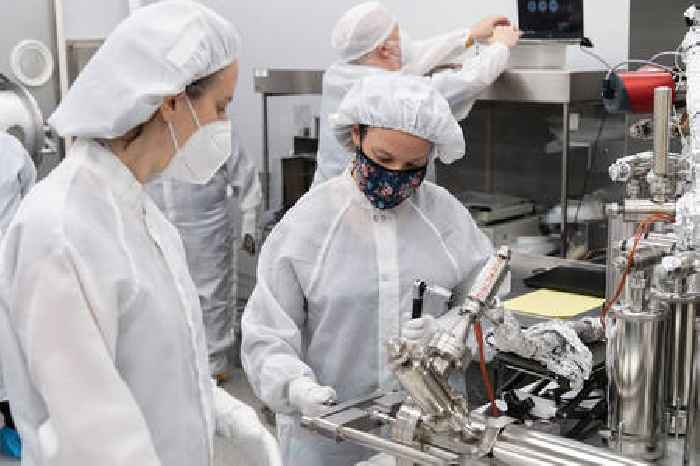Image:
A satisfying, audible ‘pop’ marked a successful piercing of the sealed Apollo 17 sample container using the ESA designed and built piercing tool. The tool forms part of a gas sampling system with a gas extraction manifold, designed and built by Washington University St Louis, USA.
Francesca McDonald, science and project lead of ESA’s contribution to the Apollo Next-Generation Sample Analysis (ANGSA) programme, is pictured at the centre of this image with the piercing tool, which contains the pristine sample.
Francesca and colleague, Timon Schild, delivered the ESA piercing tool to NASA’s Johnson Space Center in late 2021 in preparation of the opening of the specially curated Apollo 17 core sample, which had remained sealed under vacuum since its collection in 1972 at the Moon’s surface by Apollo astronaut Gene Cernan.
The job of the tool, jokingly called the “Apollo can opener” amongst the team, was to puncture the Moon sample vacuum container in such a way as to aid capturing trapped lunar gases within.
This was successfully done in February 2022, with the fragile gases then collected in dedicated canisters via an extraction manifold designed by a partner team at Washington University in Saint-Louis, USA.
“The piercing tool was bespoke designed for this Core Sample Vacuum Container (CSVC),” explains Francesca. Even if it’s not used again, she notes that, “there are a lot of lessons learned that we can take for future exploration of the Moon and Mars.”
Combined science and engineering investigations are producing a set of findings on how well the CSVC performed and what can be learnt for improving the sample return chain in the future.
The gas sample canisters are being sent to specialised laboratories around the world, including within Europe, for detailed studies using highly sensitive mass spectrometry analytical techniques to learn about the origin and evolution of volatile species on the Moon and to understand the geologic history of the Apollo 17 landing site.
Follow up work is commencing to assess the full performance of the tool and to attain a set of lessons learned for future volatile-rich sample return, containment and gas sampling, which can inform Artemis and Mars Sample Return.
The gas extraction experiment is part of the larger Apollo Next-Generation Sample Analysis (ANGSA) programme that is coordinating the analysis of several pristine Moon samples from the Apollo era. And for the first time ever, ESA is involved in the opening of soil returned from the Moon.
Pop goes the Moon
ESA
0 shares
2 views
You might like
Related news coverage
Sydney Sweeney, Fallout & Rebel Moon 2 Reviews! State of the Atmosfere Live!
Rumble
State of the Atmosfere Live! Sydney Sweeney, Fallout & Rebel Moon 2 Reviews! Pop Culture, Movies, Shows & Games!..





